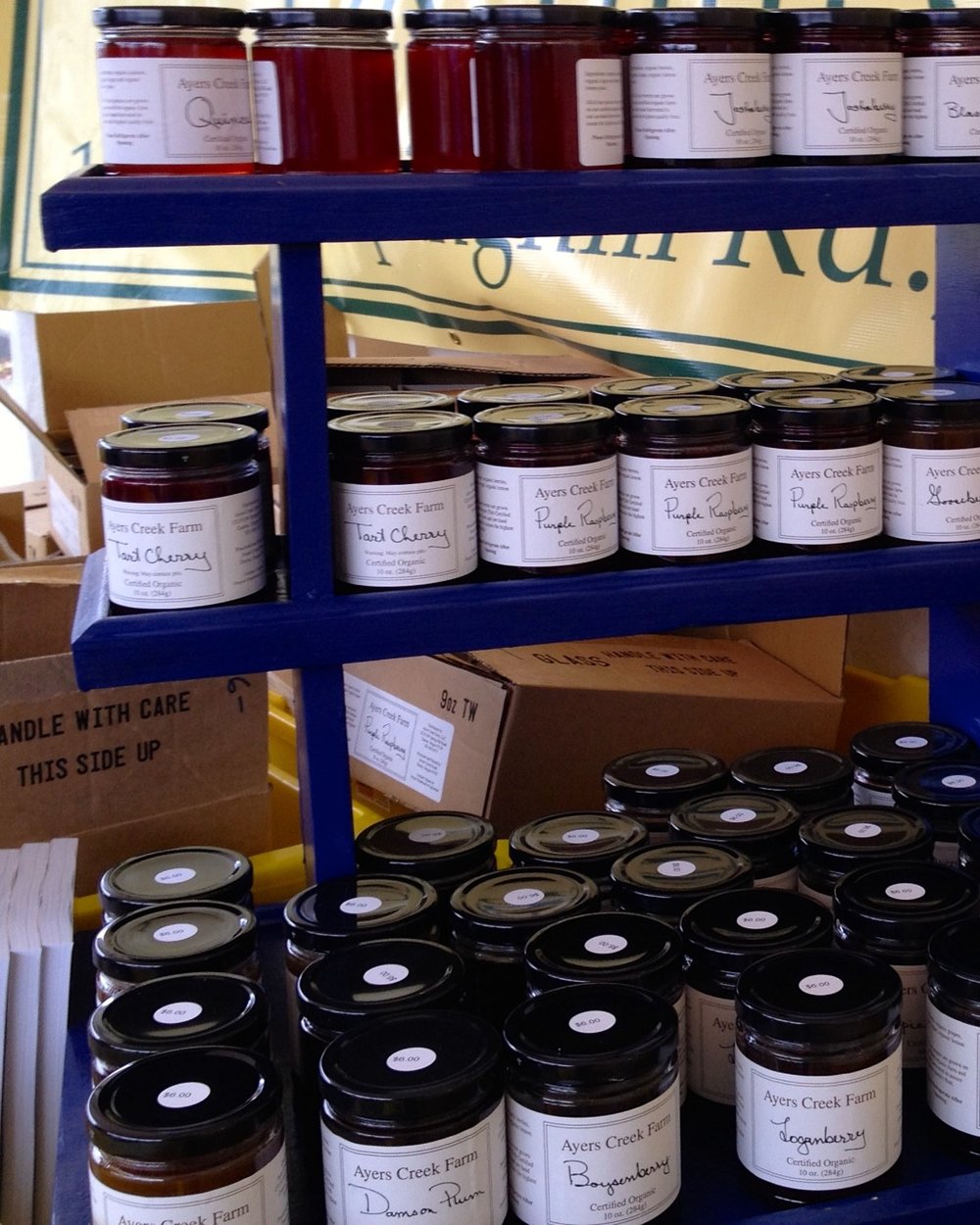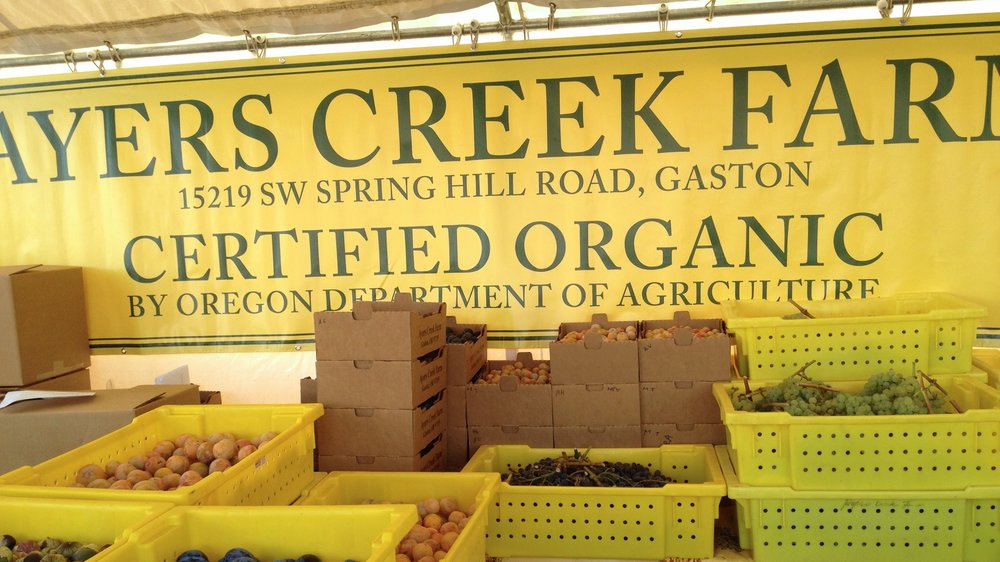Ayers Creek Farm Newsletter December 7 2014 Market
Guest User
 Back as a couple, we will return to that quaint hamlet of Hillsdale this Sunday, ready to meet some of your many late autumn needs when the market bell rings at 10:00 AM.
Back as a couple, we will return to that quaint hamlet of Hillsdale this Sunday, ready to meet some of your many late autumn needs when the market bell rings at 10:00 AM.
We will have our gift boxes of preserves. This year, the mix is raspberry, loganberry, green gage and Veepie grape, along with a biographical sketch of each fruit.
If the prospect of crating and mailing preserves is daunting, you can pass the job off to the expert hands of Gwen Vilches at Give Portland Gifts or Rebecca and Fred Gerandasy at Cooking up a Story. Links are:
giveportlandgifts.com
cookingupastory.com/store
We will have popcorn, corn & lime for preparing hominy, cornmeal, cayennes, dry beans, frikeh and hulless barley. We will also bring spuds, sweet potatoes, squash, onions, fennel, knob celery, black radish, horseradish and perhaps some other morsels.
_________________________________________
Myrtha Foradori studied in southwestern Germany for two years. During that time she signed up for a weekly produce box that provided, among other vegetables, black radishes. Made aware of our insecurity with respect to cooking black radishes, she mentioned how much she enjoyed a simple soup prepared using the root. Myrtha kindly sent along the recipe.
Potato - Black Radish soup
4-5 medium sized potatoes, chopped in cubes
half of a big black radish, thinly sliced
1 big yellow onion, chopped
some garlic, minced
olive oil
about a glass of white wine
enough vegetable or chicken broth to cover while simmering
optional: sour cream
Heat the olive oil, sauté onions and garlic. Add the potatoes and stir on medium heat. Add white wine and after it evaporated cover the potatoes with a fair amount of broth. Cover with a lid and let cook on medium heat. When the potatoes are almost done, add the black radish and cook for a short time until tender. Purée and season with salt and pepper. Serve with some sour cream.
The farm chef, Linda Colwell, prepared the soup today substituting butter and leeks, reflecting her northern European orientation. We sprinkled grated horseradish over the top. It is a very fine soup and, with specks of black skin from the radish, very attractive as well. Recommended. (printable recipe here (link).)
Tasting our grapes hanging in storage, Myrtha recounted how her mother loved to go into the family's attic where they hung their grapes for winter use and enjoy the intensely flavored, half shriveled fruit. We will have some at market this week, thanks to our patient brother-in-law who took the time to hang the clusters when visiting us in October.
________________________________________________
Escape from Vineland
The late Lon Rombaugh was amiably acquisitive when it came to fruit, especially grapes. Parsing his 2006 catalogue, we noticed he highlighted a new entry called 'Veepie', a quirky name that captured our eye. Veepie was not in his book on grape growing and he had not suggested it when he advised us on our vineyard selections. The entry noted that it is a "tart grape especially for pies." All this and a quirky name, too. We purchased 15 cuttings and rooted them. At the lower end of the vineyard, they grew with little attention for a few years.
Table grapes have an elven quality; we savor them at the moment, tarrying in the vineyard on a late afternoon enjoying the range of flavors that breeders have teased forth. Wine grapes are tasty with subtle differences, but their character develops after living underground in a dwarfish fashion, deprived of the sun for a long spate. Missing in the modern mix of commercially available varieties is the hafling, or hobbit, of grapes, a culinary fruit domestic in character, whose flavor opens up with the heat and knife of the kitchen. At one time, these grapes were an essential part of the kitchen garden. For example, John Evelyn notes that a special grape was used for verjus. Recipes from the Middle East, Persia and the Caucasus specify sour grapes as a matter of course. Yes, unripe table or wine grapes are sour, but they lack the flavor gained in the ripening process. Veepie is one of the few grapes, at least on this side of the Atlantic, that is a true culinary grape, tartly ripe and conveniently seedless.
There is a parallel here with apples. Cox's Orange Pippin or Spitzenburg are great dessert apples overwhelmed in a pie, whereas no one could ever relish the bitter, tannic cider apples such as Kingston Black or Yarlington Mill outside of the barrel. On the other hand, Rhode Island Greening, Northern Spy and Reinette Gris are excellent culinary apples for pies, tarts and sauces, yet on the tart side for enjoying out of the hand. Notably, people do not select an unripe apple for a pie, and thus it should be with grapes.
Veepie is officially 52131, a numbered seedling originating from a cross pollination made in 1952 by Oliver A. Bradt at the Vineland Experiment Station in Ontario, Canada. The mother plant was Seibel 8357, also known as Colobel. It is a teiturier, a type of grape with intense pigmentation used in small quantities to strengthen the color of wine. Albert Seibel was a French grape breeder who developed a large number high quality hybrids between American and the European wine grapes, seeking resistance to a pest called Phylloxera that had devastated the vineyards of Europe. The pollen-bearing parent was Bronx Seedless, a highly regarded but temperamental table grape prone to splitting, that is still cultivated in California. Bronx is also a hybrid with a seed parent of American lineage and Thompson seedless, a raisin grape dating back to the Ottoman Empire, also known as Sultanina.
The resulting grape has the intense pigmentation from its teiturier ancestor combined with the seedless trait and propensity for splitting, albeit much attenuated, from its pollen parent. It produces unfilled seeds which confer an additional pleasant component to its texture. As you look at the preserves, you will notice the little brown seedlets. The berry's tartness is it defining characteristic. Sugars and other soluble solids are measured using a refractometer, yielding a number given in degrees Brix (°Brix). When we harvested the grape for preserves this year, it measured 11° fully ripe. The Canadice grapes harvested at the same time for fresh eating were at 26°. As a reference, a lemon is around 8°. In its flavor, the European ancestry is evident. Bradt, as well as Seibel, selected against the "foxiness" that marked grapes with pure American lineage.
Vineland formally released numerous varieties resulting from Bradt's work. Public breeding programs used to have their own naming protocols, a custom that has faded recently. In the case of Vineland, their releases usually started with a V, such as Veeport, Vivant, Vanessa, and Vincent, with Festivee as a consistent variation on the theme. Selection 52131 survived the culling process, yet was never officially released. The vine somehow hung around long enough to catch the attention of the station's biochemist, Tibor Fukei Tibor Fuleki. He saw the grape's culinary potential for pies and preserves.
The late D. C. Paschke, a grape and chrysanthemum farmer from North East, Pennsylvania, was an insatiable collector of grapes and mum varieties. He tracked the breeding programs at Geneva (Cornell) and Vineland, and acquired a large collection of varieties. The farm was also known far and wide for his wife's grape pies, and it is likely Fukeli tipped him off to the exceptional qualities of 52131, over a slice of pie we hope, and it slipped into the vineyard at North East. With two champions in its court, the grape informally acquired the name Veepie, consistent with the naming style of the station. Rombaugh and Paschke knew each other from their shared interest in grapes, and at some point 52131 ended up in Oregon as Veepie. Instead of being released, Veepie managed to slip away from Vineland in the nick of time disguised as a release, escaping the flaming pyre reserved for seedlings deemed unworthy for release. Apparently no living trace of it remains at the station today. The numbered seedling that escapes is unusual, but SIUS 68-6-17 accomplished the same feat. That unnamed blackberry evaded the bulldozers that leveled the fields of Carbondale in 1973 by hitching a ride and hiding out in the Zych family's backyard until 1985. That is the year when it was finally released as our most beloved "Chester Thornless."
With its two primary champions dead, this hafling grape, perched between a number and a name, has attached itself to our farm. Like Fukeli, Paschke and Rombaugh, we think it is a singular grape that belongs in any well-rounded vineyard. Personally, we wish there were a greater diversity of culinary grapes, but 52131 is a good start. It certainly deserves a formal release someday.
Dr. K. Helen Fisher, Bradt's successor at Vineland, helped us sort out this story. We appreciate her willingness to provide the history of the grape, allowing us to acknowledge Bradt's role in developing it, and Fukeli as its advocate at the station. Thank you Helen. That said, any errors or flights of fancy in the above account are ours alone. We hope you all enjoy the Veepie Grape preserves.
Until Sunday,
Carol and Anthony Boutard
Ayers Creek Farm
The original post misspelled Tibor Fuleki's last name. That error has been corrected.




